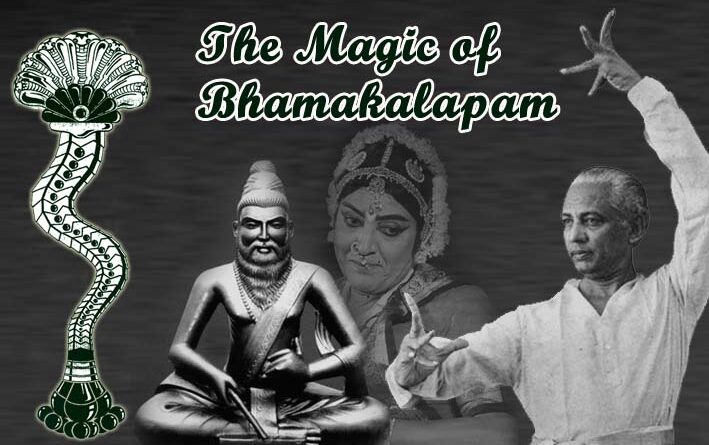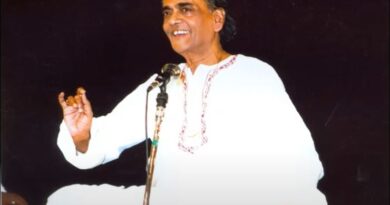The Magic of Bhamakalapam

Text By : P. Shashi Latha Krishna
M.A (DANCE), MBA
Guest Faculty in
Department of Music and Dance
Andhra University
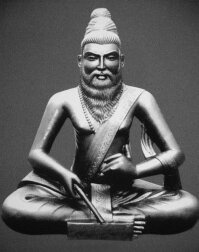
“Bhamakalapam” is a precious treasure of the Kuchipudi art form. Bhamakalapam is the “Maanasaputhrika” of Sri Siddhendra yogi who belonged to the 11th century, he trained young boys of Kuchipudi village not only Bhamakalapam but also how to perform the Kuchipudi with proper physical training, to carry on the particular character with understanding the subject and also to maintain the elegance of the role.
Bhaamakalapam is based on srigandham from uparoopaka…… “which is derived from dasarupaka of bharathas natyasastra” .The basic meaning of Sri Gadhitham is – “Expressing the inner feelings of the divine goddess”. Siddhendra yogi conceptualised Bhamakalapam with the primary message “Union of Jeevatma into the Paramathma”. Here Jeevatma is Satyabhama, Paramathma is Lord Krishna, Madhavi is Maya which is purely created by Siddendra yogi to be a source to unite them both.
Siddendra Yogi is the first author to write dance drama (Drusya prabhandha kanyam) in the Telugu language, who embraced both poetry and dramaturgy in a challenging way in his work, following the footsteps of Bharatha’s Natyasatra. The main concept of making Bhamakalapam is to spread Madhura Bhakti and to show the right path of Dharma in a simple language where all sectors of the audience can get the primary message of Bhamakalapam, his analysis of Sringara rasa (one of the eight Rasas – categorised by Bharata) is unique, covering the complete play on one type of Sringara – “Vipralambha Sringara’’ and presenting the expression in a very elegant and royal way. Siddhendra Yogi’s main theme of Sringara is the king of all rasas in which he elaborated the different stages of Avastha in Sringara, where other emotions including proudness, jealousy, sorrow, anger etc. are shown decently in Satyabhama Devi – Utthama Nayika of Lord Krishna. Hasya Rasa (hasyam/humour) is generated by Madhavi in parallel to make the play more interesting and give more entertainment to the audience.
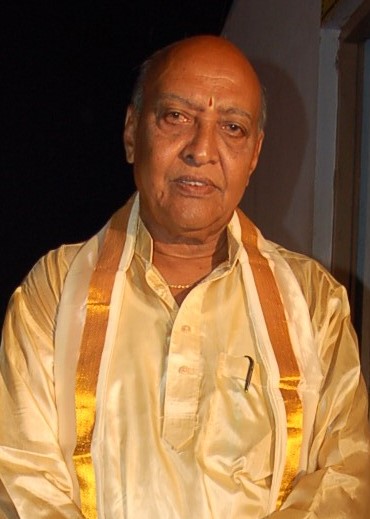
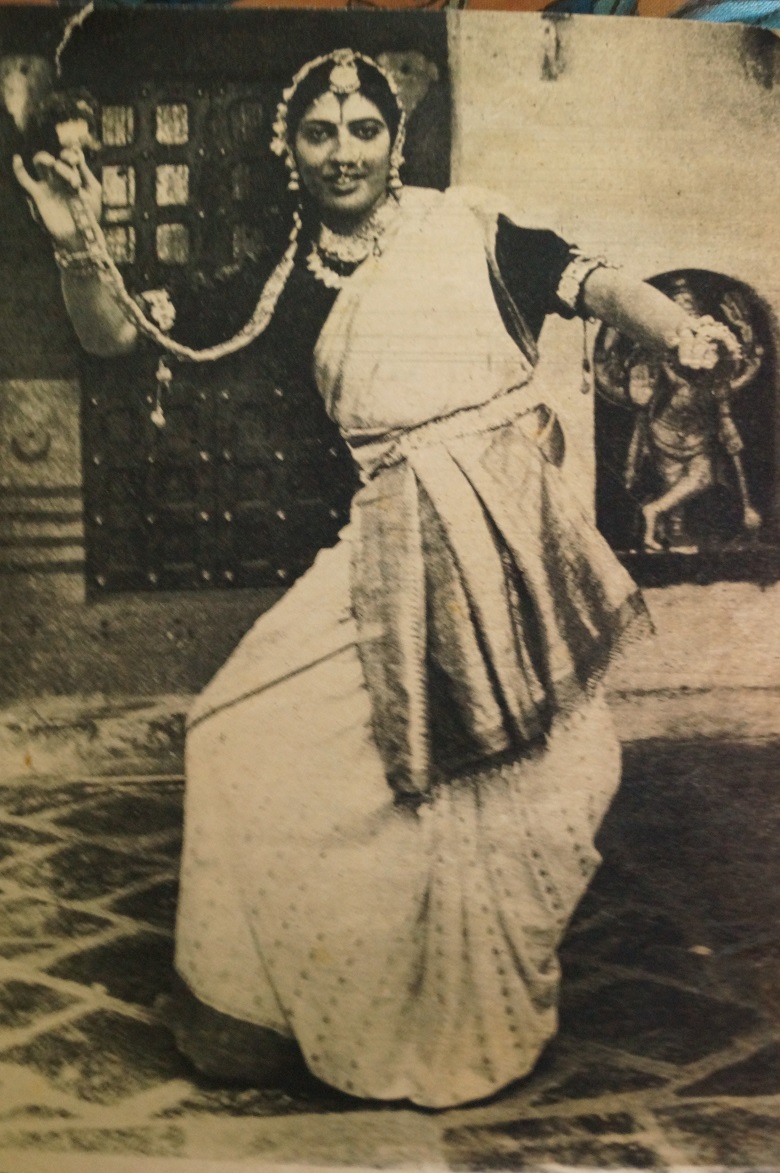
Siddhendra yogi in his Bhamakalapam made a combination of four elements of Abhinaya (Angika, Vachika, Aharya and Satvika Abhinaya) with only three characters in it, LORD KRISHNA (Paramathma), SATYABHAMA DEVI (Jeevatma) and MADHAVI (acts as a bridge between both, or Maya) with grandeur in aaharya of these characters, rich literature work, intricate foot movements and hand gestures (Hastha, Pada karma) which enacted the meaning and story primary feel till the end interestingly, it is an enormous task for a dancer to carry the mood of each segment of complete play and to maintain the all the above, training was given to the men from childhood in Kuchipudi village.
In Kuchipudi village, they gave training in Sanskrit along with physical fitness, pronouncing the words, dialogues diction, voice modulation, theoretically in-depth knowledge about the play, music training and also in technical aspects. Every family in Kuchipudi undergoes all levels of practice and every male dancer ensures to portray the Satyabhama role at least once in their lifetime and for that they get their ears and nose piercing for the female roles in Yakshaganam, dance dramas, etc. Usually, all artists sing their songs and render the dialogues in their voices.

We can say Bhamakalapam regarding literature as a complete extract of Alankaara shastra which not only surprises us and also makes us think how Siddhendra Yogi wrote it with such a great in-depth knowledge in several aspects. Siddhendra Yogi in Bhamakalapam has chosen Satyabhama as the heroine (Nayaki) for his story perfectly to represent “Jeevatma” symbolising complete humankind with Thrigunas (Sathva, Raja, Thamasa) and Arishadvargas (Kama, Krodha, Lobha, Mada, Matsarya) in them. One should win these gunas and unite into the supreme god (Paramathma) to attain moksha. Satyabhama is beautiful and proud of her charm (Soundarya Garvith), proud of her being the daughter of wealthy king Sathrajeeth, she proudly feels that Lord Krishna brought Parijatha vruksham (holy tree) from heaven, only for her and she is the most lovable among the other wives and gopikas of Krishna. With her pride, she departs from the lord.
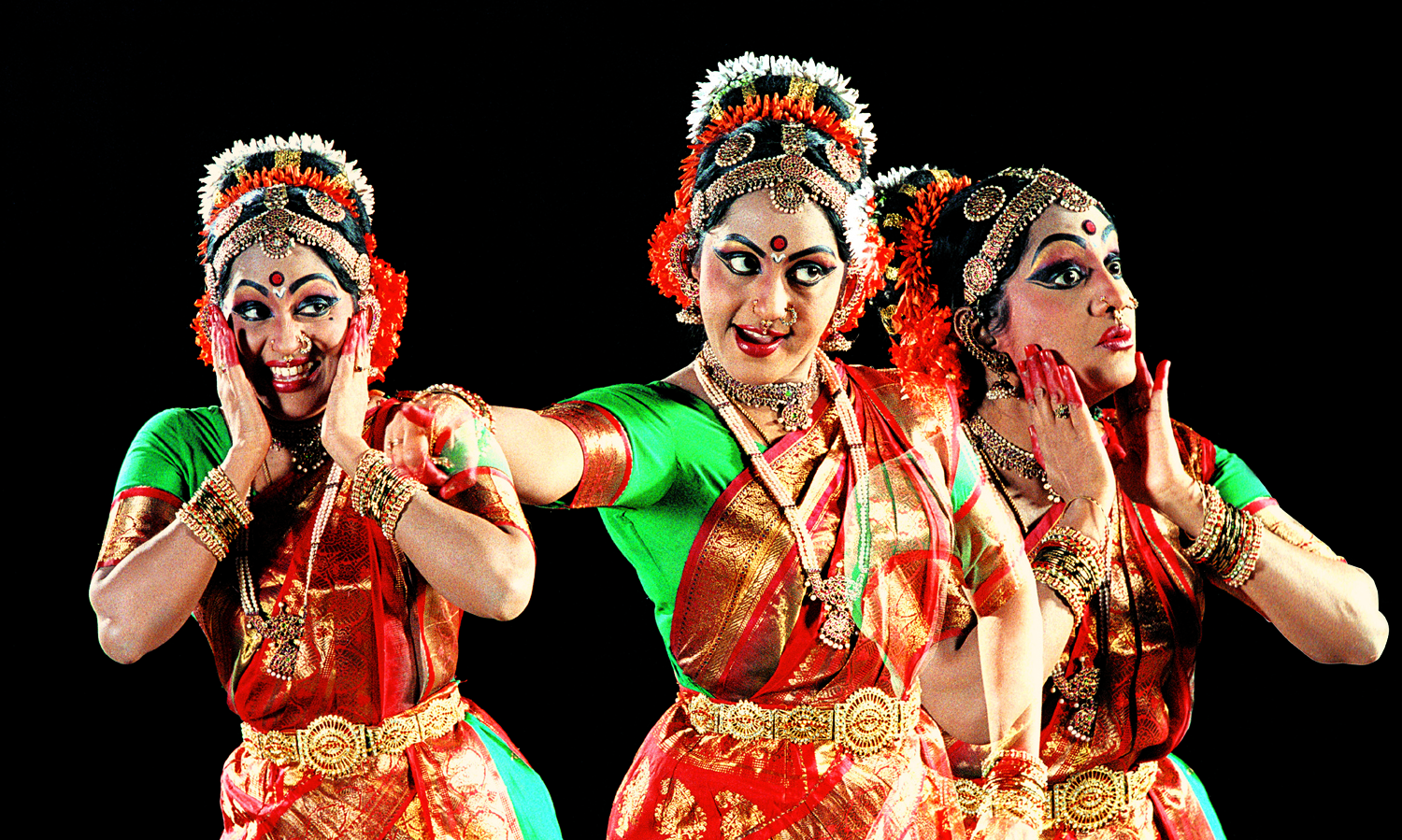
Bhama will yearn for her lord’s love in his absence. Later on she realises her mistake and unites with him. Bhama who is jealous of other wives (Ashtabharyas) of lord Krishna and 16,000 gopikas in her Pravesa daruvu (Bhama pravesa daruvu) “Bhamane… Satyabhamane…” set in raga-bhairavi and misra chapu talam where Satyabhama introduces herself in her entrance on the stage with two narthakies holding curtains with a big golden braid hung on the top of it. Satyabhama jada/veni (golden braid) is very important in the story. The story behind her braid and how it came to her after Kshirasagara Madhana Mohini avatar of Lord Vishnu. In the play, they explain it before Bhama’s entrance and they call it “Satyabhama jada varnana/bhama veni vruthantham”. We can say DARUVU as a special element in Bhamakalapam where characters introduce themselves and express their inner feelings with the audience and other characters in play.
In Daruvu, there are many daruvus like Pravesa daruvu, Samvada daruvu, Nishkramana daruvu, Lekha, Akshepikha etc. and others like Padya, Gadya, Dwipada, Seesa Padya, Gulika padya, Kandaarda padya so on, which are seen only in Kuchipudi.
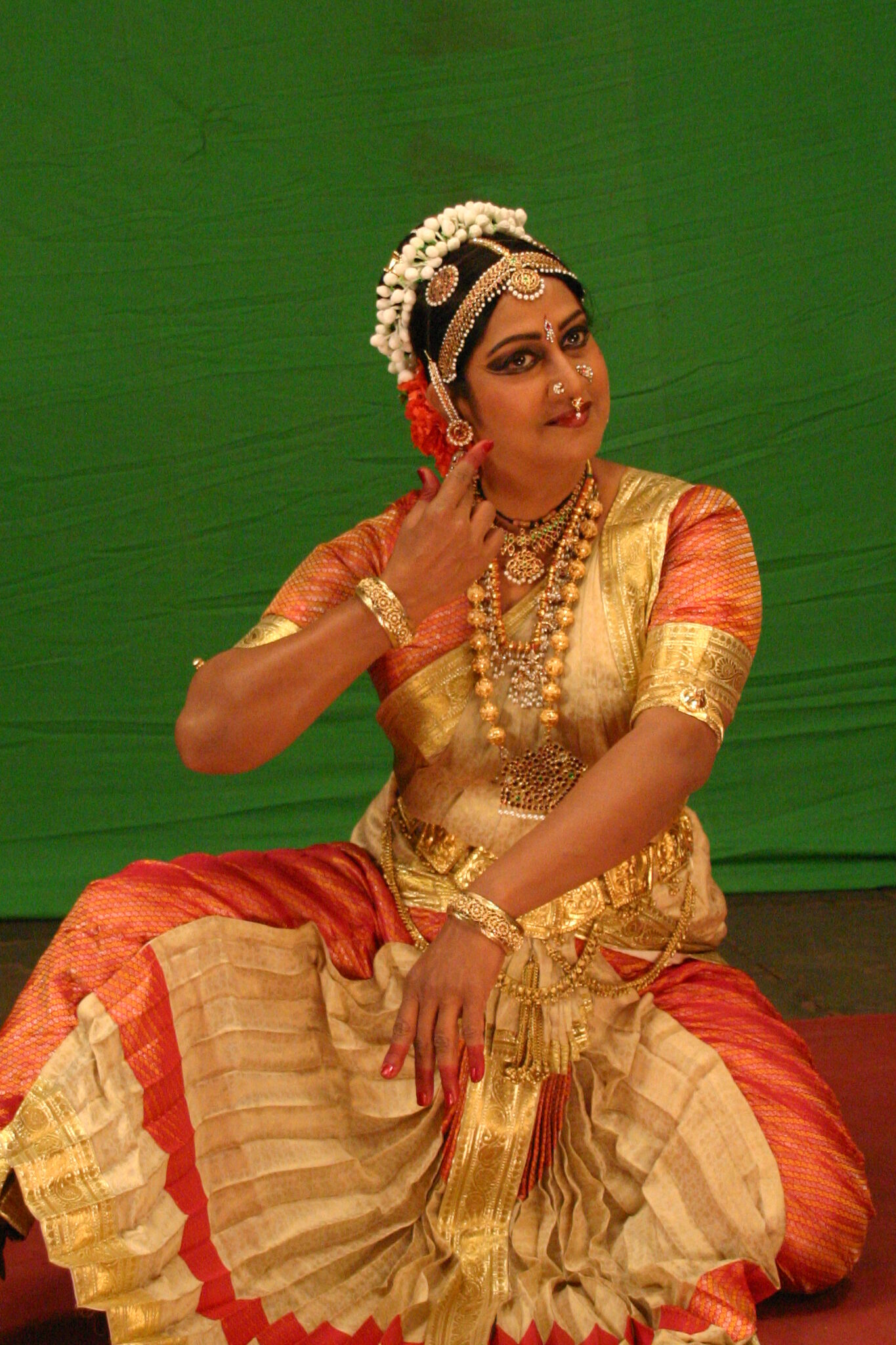
They purely based music on Carnatic music, they choose ragas according to the situation and mood of the song with different talas.Siddhendra Yogi in bhamakalapam even though conceptualised the story, conversations, songs in pure “Maargi “(margi padhathi) pattern but in parallel, he merged “Desi padhathi’’ following the manodharma of the Sootradhara and Madhavi by creating a humour to make the audience laugh with their spontaneous dialogues and with the actions, Satyabhama devi emotes bhakti and sringara, and Lord Krishna showcases mukthi and moksha margam. Siddhendra Yogi has given full freedom for future generations of gurus and dancers to further enhance.
Satyabhama’s entry: As Satyabhama enters the stage with her introduction, she expresses to Madhavi (Aantharangika Sakhi) about the quarrel between Krishna and her. Lord Krishna asks, “Bhama, are you charming or am I?” With her pride, she says that she is more charming than the lord. Then lord Krishna gets annoyed and leaves the place (Kelika gruham). So Satyabhama requests Madhavi to bring Lord Krishna to her Mandiram.
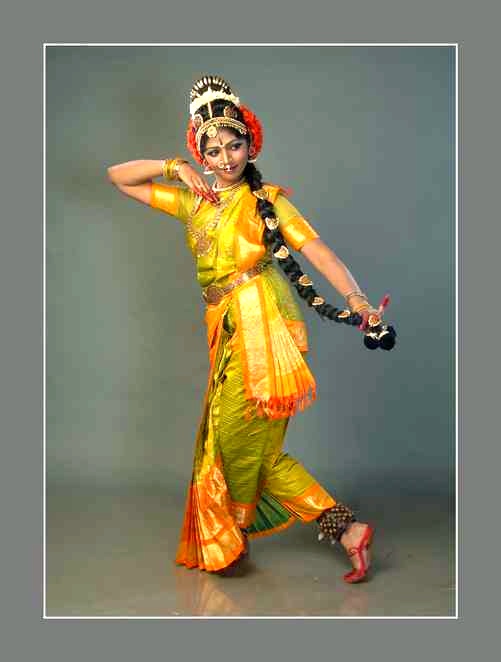
Madhavi is a very interesting character in Bhamakalapam who plays a vital role and acts as a bridge between Bhama and Lord Krishna. Madhavi is a peculiar character to play as she needs to create humour and spontaneous conversation according to the audience’s mood. She makes Satyabhama realise her mistakes, helps to get away from her pride, jealousy and anger to reunite with Lord Krishna. Madhavi makes Satyabhama understand that her wealth, pride and jealousy are worthless compared to her Lord. Madhavi demand’s all jewel’s (yedu varala nagalu) which were worn each day of the week. They presented Madhavi’s character elegantly where she wears a white dhoti, turban on head, rudraksha mala on neck and arms, shawl and with three namams on the forehead.Satyabhama now tries to offer Madhavi valuable sarees and jewellery (yedu varala nagalu) in Kandhardam… perichina pattu cheeralu. She gets shocked when Madhavi mainly demands mukkera (nose ring/nose pin) where Bhama doesn’t agree to give it and explains how important mukkera (nose pin) is for any married woman in daruvu “Angana leni illu…”. However, she eventually agrees to give away a nose pin for her husband’s love.Madhavi asks Satyabhama to give details of her husband (Krishna) such as his name and how does he look? Satyabhama tries to hint her with different postures like Shankha, Chakra and others to identify. Madhavi pretends as if she couldn’t identify and makes Bhama yearn for her lord. Madhavi — “Satyabhama ni nadhudu ye roopuvado… Ayana namadheyamu thelupavamma…”, Satyabhama — “Shankhamu dharinchinatuvanti vaade…”.
When Madhavi cannot tell Swami’s name then Satyabhama finally conveys his name. Conversation between Madhavi and Satyabhama creates humour and changes the atmosphere into fun. Later, Madhavi asks Bhama to write the message so that she can give it to Lord Krishna. Bhama writes a letter and hands it over to Madhavi. Song: Satyabhama—“Sri madhratnaakara putrika… (lekha)…”.
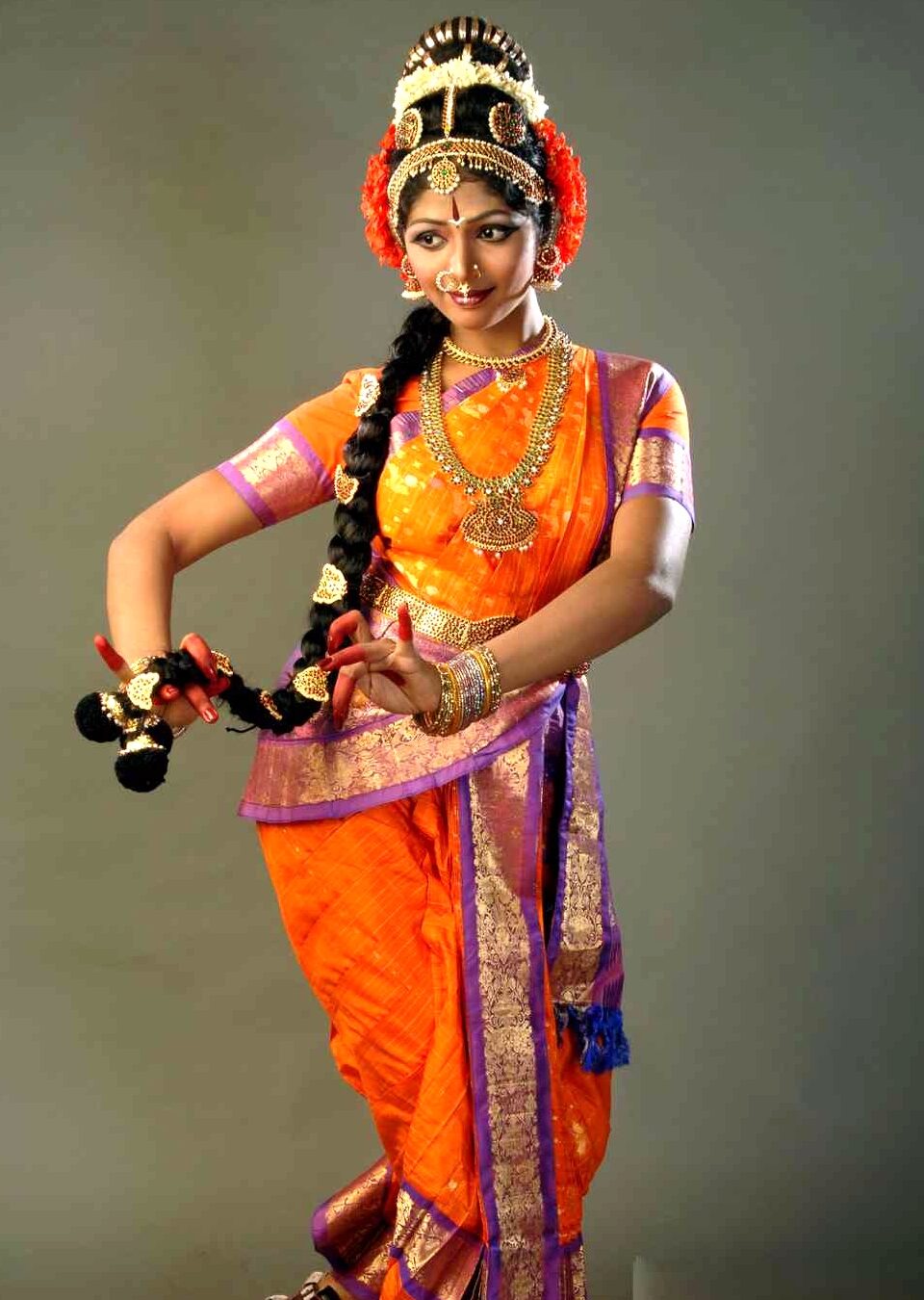
Lord Krishna’s entry: Lord Krishna enters the dais with Sri Krishna Pravesa daruvu “Raajivakshudu raja gopaludu…”. Madhavi reaches Lord Krishna and explains the situation of Bhama, how she is starving in his absence, and not able to take the separation – she lost her charm by crying for her lord.After listening to Madhavi, Lord Krishna returns to Satyabhama Mandhiram. In the meantime Satyabhama Devi eagerly waiting for Madhavi to bring Lord Krishna comes across good omens like a newly married couple, two brahmins priests reciting mantras, two Gollabhamas with a pot full of milk and curd, thunder and lightning seen in the north, and two ladies give mangala harathi in daruvu — “Sakunaalu manchivayenamma…”.Lord Krishna comes to the Bhama’s mandiram… Bhama upon watching Lord Krishna expresses happiness with no boundaries, yet she pretends annoyed with him for leaving her and going to other wives. After Lord Krishna explains everything to her, she calms down, realises that ego, pride, jealousy, anger and other such things are hurdles to reach the Paramathma. So she leaves everything behind and happily unites with Lord Sri Krishna.
It is the main essence and magic of BHAMAKALAPAM created by SRI SIDDHENDRA YOGI and continues today with the Kuchipudi artists, not only in India but across the world. The fragrance of the Kuchipudi spreads even more with the unique dance play called “BHAMAKALAPAM” which not only gives the audiences (rasikas) joy but also gives the core message about Bhakti showing the right path to reach the Paramatma and attain moksha siddhi.

